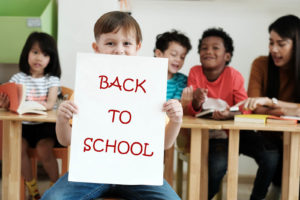
Back to School: Identifying Students with Vision Impairments
As we usher in a new school year, it’s time to get our kids back into their school routines. As we buy pencils, glue sticks, and notebooks to get them learning-ready, we can’t forget the most important thing this year: getting their eyes checked. A student’s vision is the most important key to success.
If you want your child to hit the ground running this term, make sure that they have the vision to do it. We live in a visual world where 80 percent of learning is done visually! Identifying vision impairments in school-aged children is imperative to their learning.
Visual Skills: The Secret Prerequisites for School

When you enroll your six-year-old child into the first grade, you don’t expect there to be any prerequisites. They’ve only just begun their learning journey! To expect them to have any developed skills besides finger painting and running would be ludicrous!
However, there is a learning skill in school that we don’t often talk about: visual skills. Your child doesn’t need to be able to read just yet, but they need to be able to see. If your child does not have the vision they need to learn, their self-esteem and grades will suffer.
Different Skills
Here are the visual skills your child needs to excel in their academic career:
- Visual Acuity: Visual acuity is needed for precise vision. This is extremely important for seeing writing on the chalkboard, learning how to read and make out letters, and reading a computer screen.
- Hand-Eye Coordination: Hand-eye coordination refers to the way the eyes and the body work together. This type of coordination is important for developing skills like drawing and playing sports.
- Focusing: A focused eye will be able to focus on one object for long periods of time. We use this skill when reading books, writing reports, working on math problems, and reading the chalkboard.
- Eye Teaming and Tracking: Eye tracking is when both eyes are working together to focus on a target. Eye teaming is the ability to coordinate the eyes to do so. This is used while reading (the eyes move back and forth along the page) and while playing sports (the eyes lock in on a ball or player that is constantly moving).
- Visual Perception: Though all of the skills mentioned are important to learning, visual perception is perhaps the most important. Visual perception is the skill needed to organize the words and pictures being seen and to remember what they are and what they mean. This is crucial for a child just beginning to learn to read.
When a child does not have even just one of these skills, it can make their learning experience a difficult one. They may lose interest in learning because their poor vision is preventing them from learning effectively and efficiently.
Problems in a student’s vision can also cause children to experience frequent headaches, eye strain, and fatigue.
How to Spot Problems in a Student’s Vision
Parents and teachers alike should always be on the lookout for children who may have underdeveloped visual skills or vision conditions. Pay extra attention to children who seem to be having difficulty learning because a learning problem isn’t always due to ADHD or some other learning disability.
Sometimes when a child has difficulty learning or seems to not want to learn at all, it is because they are having trouble with their vision. Before your child loses their love for learning, look for poor vision signs and get your child the eye care they need and deserve.
It won’t always be obvious when a child has vision problems. They, of course, will not recognize poor vision because they do not know any other type of vision and will think that how they see is normal.
Signs During Reading
The first sign to look for is frequent eye rubbing. This one is an easy one to spot. If you find that your child (or your student, if you’re a teacher) constantly rubs their eyes, especially while reading or doing other close work like drawing, it could mean that your child is nearsighted.
As a bonus, eye rubbing may be accompanied by head tilting while they try to read or see things close to the eye like a computer or television screen.
Another sign to look for is the turning out of one eye. When an eye begins to turn out, it could be a sign of amblyopia (lazy eye). Amblyopia is very common among young children. Typically it isn’t anything to worry about if caught early because it can be easily treated. However, after the age of seven, it becomes more difficult to treat.
One last sign to look for is a behavioral sign. If your child has difficulty remembering what they just finished reading, it may not be poor memory, but it could be poor visual perception.
Questions to Ask Your Child
You won’t be able to know the symptoms of poor vision that your children are experiencing because you can’t see it on the surface. The only way to know is to ask your child about it.
If you notice that your child seems to be having vision problems, ask them the following questions:
- Do you get headaches at school or while doing homework?
- Do you see double?
- Are the words on the page and on the chalkboard look fuzzy or blurry?
If your child answers yes to any of these questions, they may be having vision problems. Contact your eye doctor for a proper diagnosis.
When to Bring Your Child to the Eye Doctor: Assessing Your Student’s Vision
Knowing when to call in the experts can be difficult. You don’t want to take your child to the eye doctor every time you suspect something is wrong. That won’t be fun for your child or your wallet.
The general consensus is that school-aged children should have an eye exam done by a healthcare professional at least once a year. This is because a student’s vision is their most important tool. What better time to do it than at the beginning of a new semester?
If your child has an existing condition, they should see their eye doctor as often as recommended by their doctor. Your child should also go for an eye exam if their poor eye signs and symptoms last longer than a month.
Start your child off on the right foot this year and have their eye checked!
Our Rebuild Your Vision Ocu-Plus Formula Contains All 17 Vitamins, Minerals, and Herbal Supplements to Improve Your Eye Health!












Leave Your Reply